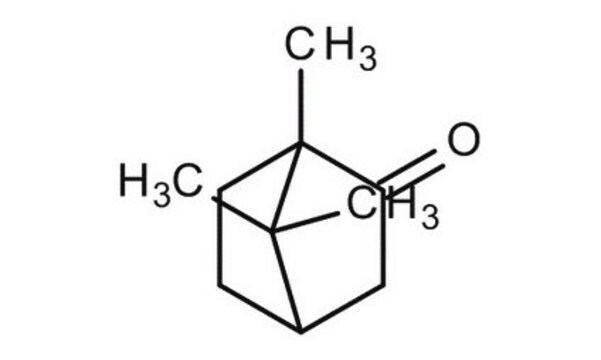1087508
USP
Camphor
United States Pharmacopeia (USP) Reference Standard
Synonym(s):
D-Camphor, 2-Bornanone, 2-Camphanone
About This Item
Recommended Products
grade
pharmaceutical primary standard
vapor density
5.24 (vs air)
vapor pressure
4 mmHg ( 70 °C)
API family
methyl benzylidene camphor
autoignition temp.
870 °F
expl. lim.
3.5 %
manufacturer/tradename
USP
mp
178-182 °C (lit.)
application(s)
pharmaceutical (small molecule)
format
neat
SMILES string
CC1(C)[C@@H]2CC[C@@]1(C)C(=O)C2
InChI
1S/C10H16O/c1-9(2)7-4-5-10(9,3)8(11)6-7/h7H,4-6H2,1-3H3/t7-,10+/m1/s1
InChI key
DSSYKIVIOFKYAU-XCBNKYQSSA-N
Looking for similar products? Visit Product Comparison Guide
General description
Application
- Camphorated Phenol Topical Gel
- Camphorated Phenol Topical Solution
- Eucalyptus Oil
Analysis Note
Other Notes
related product
Signal Word
Danger
Hazard Statements
Precautionary Statements
Hazard Classifications
Acute Tox. 4 Inhalation - Eye Dam. 1 - Flam. Sol. 2 - Skin Irrit. 2 - STOT SE 2 Inhalation
Target Organs
Lungs
Storage Class Code
4.1B - Flammable solid hazardous materials
WGK
WGK 1
Flash Point(F)
147.2 °F - closed cup
Flash Point(C)
64 °C - closed cup
Certificates of Analysis (COA)
Search for Certificates of Analysis (COA) by entering the products Lot/Batch Number. Lot and Batch Numbers can be found on a product’s label following the words ‘Lot’ or ‘Batch’.
Already Own This Product?
Find documentation for the products that you have recently purchased in the Document Library.
Customers Also Viewed
Our team of scientists has experience in all areas of research including Life Science, Material Science, Chemical Synthesis, Chromatography, Analytical and many others.
Contact Technical Service












